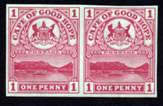On the 21st January 1900, a One-Penny stamp of an entirely new design was issued for the purpose of commemorating the establishment of Imperial Penny Postage.
Although most of the British Colonies have adopted the Penny Postage much earlier in Cape Town it only came into actual force as from the 1st September 1899. The emblematical figure of “Hope” is no longer the central feature, and the lady now appears merely as a speck surmounting the coat of arms of Colony of Cape of Good Hope, whilst the anchor is present only by inference.
 The lower half of the stamp is occupied by a view of Table Bay, with a vessel in the foreground, whilst in the distance Table Mountain and the Lion’s Head are seen. Below the view a coloured label contains the words ” one penny ” in uncoloured ornamental letters, and the value is also expressed by coloured numerals contained in white squares at each corner of the stamp. In the upper portion of the design the Cape of Good Hope coat of arms is seen in a white circle surmounted by a white semicircular tablet, containing the words ” cape of good hope ” in ornamental capitals, whilst immediately below another small label contains the word ” postage,” also in small decorative capitals.
The lower half of the stamp is occupied by a view of Table Bay, with a vessel in the foreground, whilst in the distance Table Mountain and the Lion’s Head are seen. Below the view a coloured label contains the words ” one penny ” in uncoloured ornamental letters, and the value is also expressed by coloured numerals contained in white squares at each corner of the stamp. In the upper portion of the design the Cape of Good Hope coat of arms is seen in a white circle surmounted by a white semicircular tablet, containing the words ” cape of good hope ” in ornamental capitals, whilst immediately below another small label contains the word ” postage,” also in small decorative capitals.
The new die was prepared and Messrs. De La Rue & Co. manufactured the stamps from the original drawing of Mr. E. Sturman of the Capetown Post Office staff.
New Penny Postage Stamp. – A new 1d. postage stamp was brought into use on the 1st January, 1900. The design – a representation of Table Bay with Table Mountain in the background, and the arms of the Colony above – was intended to more clearly identify the stamp with the Colony, and to form the commencement, co-temporaneous with the introduction of Imperial Penny Postage, of a series of pictorial stamps similar to those adopted by New Zealand, Tasmania, and many British Colonies and Foreign Countries.
Unfortunately, owing to the first issue of the new stamp having been made during a period of great political excitement, consequent on the war, an endeavour has been made by a section of the press to place a postal change, the basis of the adverse criticism being apparently an erroneous impression that the figure of “Hope.” which has been portrayed on the Cape Colony series of postage stamps since stamps were first introduced, represented “Britannia.” and, therefore, that the adoption of any other design at the present time must proceed from a disloyal feeling towards the Crown. As a matter of fact, however, the design now adopted was first prepared in the year 1892, and the dies and plates for the present issue were in the hands of the engravers many months before the outbreak of war. Owing to the stamps of the Cape Colony being prepared on the “surface printing” system, with a view to the prevention of forgery, the designs cannot, it should be mentioned, be executed with the same fineness of detail and beauty of finish as with stamps prepared by other and less secure processes; but the Government has hitherto considered it more prudent to sacrifice, to some extent, appearance to safety. Messrs. De la Rue & Company, the manufacturers, have devoted an immense amount of time, skill, and capital to the perfecting of their processes, and are perhaps the largest manufacturers of postage stamps in the world (Postmaster’s General Report 1899, p. 37).




Good morning I am the lucky owner of what I call table top mountain red penny. Twill send a photo it is still attached to the paper and has a post mark, though its hard to read the details. I purchased a bag of random stamps from a charity shop. my research on this stamp has led me to you, and what a story.
yours sincerely Kevin